|
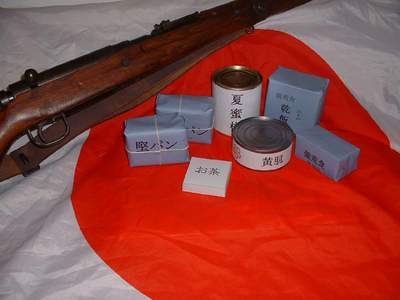
One lesson that the Japanese
high command did not learn from problems encountered re-supplying forces in the vast expanses of China and throughout the
Pacific was that of avoiding sibling rivalry between the branches, and so much design and production effort was wasted in
creating separate equipment for much of Navy and Army Forces.
Luckily, with regards
to service rations, there were some slight differences but no major chasm between the standard issue rations naval and land
forces personnel received. Only in the specialist and survival rations were there any noticeable differences.
Whenever possible, the
Japanese military tried to issue troops with hot rations, prepared by central kitchens, adhering to a pre-set meal plan.
Standard Rations:
Standard rations generally
consisted of rice as a main ingredient, fish, meat or fowl and soup base, as well as spices and condiments, fruit and tea.
These rations prepared
by the mess section or shipboard messes were generally supplemented with locally obtained vegetables and fruit. In areas where
such was not possible, mess rations were supplemented with tinned fruit and vegetables, the former as a dessert issue, the
latter as an extension of the meal.
Click here to go to a listing of the components and foodstuffs included/allocated as the Field Ration Japanese troops (both Army and Navy components) were fed per man, per day.
Specialty
and Emergency Rations:
Specialty Rations included a variety
of preserved rations, which duplicated the field ration but with more portable/durable goods. Click here to have a look at the Preserved Rations of the Japanese Armed Forces. These were issued where transport space was at a premium and rations had to be light enough
to be air-droppable or man-portable.
Other specialty rations
were broken down as follows:
'A' Emergency
Ration, consisting of:
Rice, 825 grams (approx. 29 ounces in paper sack)
Meat or Fish, Tinned 170 grams (approx. 5
ounces)
Miso Powder, 15 Grams (approx. ½ ounce, small
wrap)
Sugar, 15 grams (approx. ½ ounce, small wrap)
| Still made, Still popular, Still High Carb! |
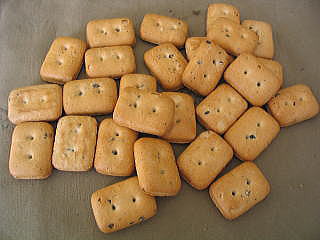
|
| Kanpan! |
'B' Emergency
Ration consisting of Hard Tack Crackers, so-called 'Kanpan'
These
consisted of either three muslin bags each containing 225 grams (approx 8 ounces), 6 paper-wrapped cellophane packages of
100 grams each, or, late in the war, 6 small boxes containing smaller Kanpan. About 200 grams were considered a meal, and
this rations was to be consumed only upon the order from an officer.
See
picture below for size differences between early (left) and late (right) Kanpan.
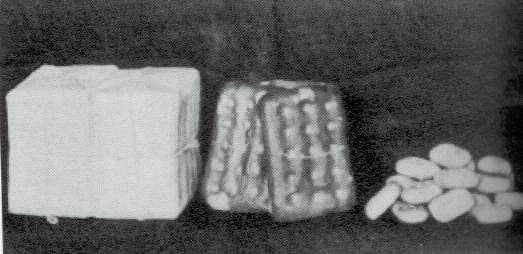
The 'Assaku
Koryo' (Compressed Ration), consisting of cooked rice (dried), pickled plums, dried fish, salt and sugar.
All versions
of the Assaku Koryo have the individual components sealed inside cellophane bags. Early issues of Assaku Koryo were packaged
in metal containers, similar to Canadian emergency rations or British meat tins.
About mid-war
(and with U.S. air strikes starting to threaten the outlying industrial areas), packaging for these rations changed, allowing
smaller cottage-industry plants to make individual components of the rations which were then either packed into their outer
covers at shipping centers, or at the issue points.
This cottage
industry made use of all existing Japanese resources, and one can safely say that, for example, any Kanpan or pre-packed dried
plums were processed by school children. Most components came in small boxes with waxed or otherwise water repellent wrappers.
Below
are some samples of some original Assaku Koryo rations. Note the early version (Metal container) on the left.
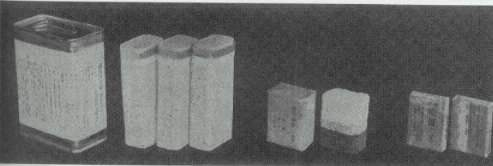
Netsuryo
Shoku ('High Nutrition Ration') was another attempt to pack several meals into a very small packet.
These
rations came in a variety of formats. Some were nothing more than hard sweets and rice crackers boxed together, while others
were peanut and/or sesame based bars, each vitamin enriched and packing massive calories.
These
are some pictures of actual Netsuryo Shoku. Note the box and bar-shaped rations. The bars had a berry-blue outer paper wrapper,
which held either 2 or 3 days' worth of bars. Japanese Navy aviation handbooks suggest eating grass or seaweed with them,
in order to have sufficient roughage and to also stave off hunger pangs between rations.
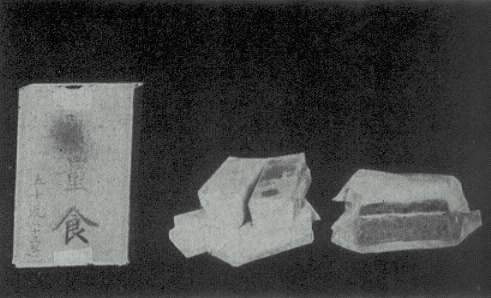
Additional
Rations:
Whenever possible, "Soldiers'
Store" outlets were opened by the Japanese quartermaster corps in occupied areas and garrison towns. These sold everyday comfort
items, snack foods, beer and whine when available, as well as magazines, newspapers, tobacco products and stationary.
Click here to go to a partial listing of Soldiers' Store goods.
|

